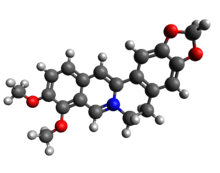Berberine

| |

| |
| Names | |
|---|---|
| Preferred IUPAC name
9,10-Dimethoxy-5,6-dihydro-2H-7λ5-[1,3]dioxolo[4,5-g]isoquinolino[3,2-a]isoquinolin-7-ylium | |
| Other names
Umbellatine;
5,6-Dihydro-9,10-dimethoxybenzo[g]-1,3-benzodioxolo[5,6-a]quinolizinium | |
| Identifiers | |
3D model (JSmol)
|
|
| 3570374 | |
| ChEBI | |
| ChEMBL | |
| ChemSpider | |
| DrugBank | |
| ECHA InfoCard | 100.016.572 |
| EC Number |
|
| KEGG | |
PubChem CID
|
|
| UNII | |
CompTox Dashboard (EPA)
|
|
| |
| |
| Properties | |
| C20H18NO4+ | |
| Molar mass | 336.366 g·mol−1 |
| Appearance | Yellow solid |
| Melting point | 145 °C (293 °F; 418 K)[1] |
| Slowly soluble[1] | |
Except where otherwise noted, data are given for materials in their standard state (at 25 °C [77 °F], 100 kPa). | |
| Infobox references | |
Berberine is a quaternary ammonium salt from the protoberberine group of benzylisoquinoline alkaloids found in such plants as Berberis, such as Berberis vulgaris (barberry), Berberis aristata (tree turmeric), Mahonia aquifolium (Oregon grape), Hydrastis canadensis (goldenseal), Xanthorhiza simplicissima (yellowroot), Phellodendron amurense (Amur cork tree),[2] Coptis chinensis (Chinese goldthread), Tinospora cordifolia, Argemone mexicana (prickly poppy), and Eschscholzia californica (Californian poppy). Berberine is usually found in the roots, rhizomes, stems, and bark.[3]
Due to its yellow color, Berberis species were used to dye wool, leather, and wood.[4] Under ultraviolet light, berberine shows a strong yellow fluorescence,[5] making it useful in histology for staining heparin in mast cells.[6] As a natural dye, berberine has a color index of 75160.
Research and adverse effects[]
The safety of using berberine for any condition is not adequately defined by high-quality clinical research.[7]
Its potential for causing adverse effects is high, including untoward interactions with prescription drugs, reducing the intended effect of established therapies.[7] Berberine inhibits the CYP2D6 and CYP3A4 enzymes which are involved in metabolism of endogenous substances and xenobiotics, including many prescription drugs.[8]
It is particularly unsafe for use in children.[7]
Biosynthesis[]

The alkaloid berberine has a tetracyclic skeleton derived from a benzyltetrahydroisoquinoline system with the incorporation of an extra carbon atom as a bridge. Formation of the berberine bridge is rationalized as an oxidative process in which the N-methyl group, supplied by S-adenosyl methionine (SAM), is oxidized to an iminium ion, and a cyclization to the aromatic ring occurs by virtue of the phenolic group.[9]
Reticuline is known as the immediate precursor of protoberberine alkaloids in plants.[10] Berberine is an alkaloid derived from tyrosine. L-DOPA and 4-hydroxypyruvic acid both come from L-tyrosine. Although two tyrosine molecules are used in the biosynthetic pathway, only the phenethylamine fragment of the tetrahydroisoquinoline ring system is formed via DOPA, the remaining carbon atoms come from tyrosine via 4-hydroxyphenylacetaldehyde. L-DOPA loses carbon dioxide to form dopamine 1. Likewise, 4-hydroxypyruvic acid also loses carbon dioxide to form 4-hydroxyphenylacetaldehyde 2. Dopamine 1 then reacts with 4-hydroxy-phenylacetaldehyde 2 to form (S)-norcolaurine 3 in a reaction similar to the Mannich reaction. After oxidation and methylation by SAM, (S)-reticuline 4 is formed. (S)-reticuline serves as a pivotal intermediate to other alkaloids. Oxidation of the tertiary amine then occurs and an iminium ion is formed 5. In a Mannich-like reaction the ortho position to the phenol is nucleophilic, and electrons are pushed to form 6. Product 6 then undergoes keto–enol tautomerism to form (S)-scoulerine, which is then methylated by SAM to form (S)-tetrahydrocolumbamine 7. Product 7 is then oxidized to form the methylenedioxy ring from the ortho-methoxyphenol, via an O2-, NADPH- and cytochrome P450-dependent enzyme, giving (S)-canadine 8. (S)-canadine is then oxidized to give the quaternary isoquinolinium system of berberine. This happens in two separate oxidation steps, both requiring molecular oxygen, with H2O2 and H2O produced in the successive processes.[11]
References[]
- ^ a b The Merck Index, 10th Ed. (1983), p.165, Rahway: Merck & Co.
- ^ Zhang Q, Cai L, Zhong G, Luo W (2010). "Simultaneous determination of jatrorrhizine, palmatine, berberine, and obacunone in Phellodendri Amurensis Cortex by RP-HPLC". Zhongguo Zhong Yao Za Zhi = Zhongguo Zhongyao Zazhi = China Journal of Chinese Materia Medica. 35 (16): 2061–4. doi:10.4268/cjcmm20101603. PMID 21046728.
- ^ "Berberine". PubChem, National Library of Medicine, US National Institutes of Health. March 9, 2020. Retrieved March 10, 2020.
- ^ Gulrajani, ML (2001). "Present status of natural dyes". Indian Journal of Fibre & Textile Research. 26: 191–201 – via NISCAIR Online Periodicals Repository.
- ^ Weiß, Dieter (2008). "Fluoreszenzfarbstoffe in der Natur" (in German). Retrieved 17 July 2009.
- ^ "B3251 Berberine chloride form". Sigma-Aldrich. 2013. Retrieved 2 Aug 2013.
- ^ a b c "Berberine: MedlinePlus Supplements". MedlinePlus, National Library of Medicine, US National Institutes of Health. 19 January 2019. Retrieved 15 February 2019.
- ^ Hermann R, von Richter O (September 2012). "Clinical evidence of herbal drugs as perpetrators of pharmacokinetic drug interactions". Planta Medica. 78 (13): 1458–77. doi:10.1055/s-0032-1315117. PMID 22855269.
- ^ Dewick, P. (2009). Medicinal Natural Products: A Biosynthetic Approach (3rd ed.). West Sussex, England: Wiley. p. 357. ISBN 978-0-471-49641-0.
- ^ Park SU, Facchini PJ (June 2000). "Agrobacterium rhizogenes-mediated transformation of opium poppy, Papaver somniferum l., and California poppy, Eschscholzia californica cham., root cultures". Journal of Experimental Botany. 51 (347): 1005–16. doi:10.1093/jexbot/51.347.1005. PMID 10948228.
- ^ Dewick, P. (2009). Medicinal Natural Products: A Biosynthetic Approach (3rd ed.). West Sussex, England: Wiley. p. 358. ISBN 978-0-471-49641-0.
- Aromatase inhibitors
- Benzodioxoles
- DNA-binding substances
- Isoquinoline alkaloids
- Nitrogen heterocycles
- Quaternary ammonium compounds